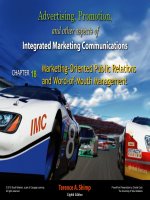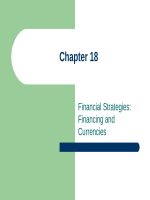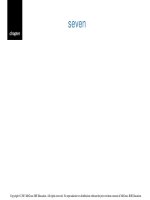Lecture M: Marketing (4/e) - Chapter 18: Advertising, public relations, and sales promotions
Bạn đang xem bản rút gọn của tài liệu. Xem và tải ngay bản đầy đủ của tài liệu tại đây (620.84 KB, 37 trang )
����������������������������������������������������������������������������������������������������������������������������������������������������������������������������������������������������������������������������������������������������������������������������������������������������������������������������������������������������������������������������������������������������������������������������������������������������������������������������������������������������������������������������������������������������������������������������������������������������������������������������������������������������������������������������������������������������������������������������������������������������������������������������������������������������������������������������������������������������������������������������������������������������������������������������������������������������������������������������������������������������������������������������������������������������������������������������������������������������������������������������������������������������������������������������������������������������������������������������������������������������������������������������������������������������������������������������������������������������������������������������������������������������������������������������������������������������������������������������������������������������������������������������������������������������������������������������������������������������������������������������������������������������������������������������������������������������������������������������������������������������������������������������������������������������������������������������������������������������������������������������������������������������������������������������������������������������������������������������������������������������������������������������������������������������������������������������������������������������������������������������������������������������������������������������������������������������������������������������������������������������������������������������������������������������������������������������������������������������������������������������������������������������������������������������������������������������������������������������������������������������������������������������������������������������������������������������������������������������������������������������������������������������������������������������������������������������������������������������������������������������������������������������������������������������������������������������������������������������������������������������������������������������������������������������������������������������������������������������������������������������������������������������������������������������������������������������������������������������������������������������������������������������������������������������������������������������������������������������������������������������������������������������������������������������������������������������������������������������������������������������������������������������������������������������������������������������������������������������������������������������������������������������������������������������������������������������������������������������������������������������������������������������������������������������������������������������������������������������������������������������������������������������������������������������������������������������������������������������������������������������������������������������������������������������������������������������������������������������������������������������������������������������������������������������������������������������������������������������������������������������������������������������������������������������������������������������������������������������������������������������������������ission (FCC) (1934)
Regulates interstate and
international communications by
radio, television, wire, satellite,
and cable.
Enforces restrictions on
broadcasting material that
promotes lotteries (with some
exceptions); cigarettes, little
cigars, or smokeless tobacco
products; or that perpetuates a
fraud. Also enforces laws that
prohibit or limit obscene, indecent,
or profane language.
Food and Drug
Administration (1930)
Regulates food, dietary
supplements, drugs, cosmetics,
medical devices (including
radiation emitting devices such as
cell phones), biologics (biological
issues), and blood products.
Regulates package labeling and
inserts, definition of terms such as
“light” and “organic,” and required
disclosure statements (warning
labels, dosage requirements,
etc.).
1820
Public Relations
PR Element
Function
Publications: Brochures, special-purpose singleissue publications such as books
Inform various constituencies about the activities
of the organization and highlight specific areas of
expertise.
Video and audio: Programs, public service
announcements
Highlight the organization or support causerelated marketing efforts.
Annual reports
Give required financial performance data and
inform investors and others about the unique
activities of the organization.
Media relations: Press kits, news releases,
speeches, event sponsorships
Generate news coverage of the organization’s
activities or products/services.
Electronic media: Websites, e-mail campaigns
Websites can contain all the previously mentioned
toolbox elements, while e-mail directs PR efforts
to specific target groups.
TOMS Shoes Website
1821
check yourself
•
•
Why do companies use public relations as
part of their IMC strategy?
What are the elements of a public relations
toolkit?
1822
Types of Sales Promotion
Promotion
Advantages
Disadvantages
Coupons
• Stimulates demand.
• Allows for direct tracing of sales.
• Has low redemption rates.
• Has high cost.
Deals
• Encourages trial.
• Reduces consumer risk.
• May reduce perception of value.
Premiums
• Builds goodwill.
• Increases perception of value.
• Consumers buy for premium, not product.
• Has to be carefully managed.
Contests
• Increases consumer involvement.
• Generates excitement.
• Requires creativity.
• Must be monitored.
Sweepstakes
• Increases involvement with the product.
• Sales often decline after the sweepstakes is over.
Samples
• Encourages trial.
• Offers direct involvement.
• Has high cost to the firm.
Loyalty Programs
• Creates loyalty.
• Encourages repurchase.
• Has high cost to the firm.
POP Displays
• Provides high visibility.
• Encourages brand trial.
• Is difficult to get a good location in the store.
• Can be costly to the firm.
Rebates
• Stimulates demand.
• Increases value perception.
• Is easily copied by competitors.
• May just advance future sales.
Product Placement
• Displays products nontraditionally.
• Demonstrates product uses.
• Firm often has little control over display.
• Product can be overshadowed.
1823
Evaluated Sales Promotions
using Marketing Metrics
1824
check yourself
•
•
What are various forms of sales
promotions?
What factors should a firm consider when
evaluating a sales promotion?
1825
Glossary
An advertising plan is a subsection of the firm’s
overall marketing plan that explicitly analyzes the
marketing and advertising situation, identifies the
objectives of the advertising campaign, clarifies a
specific strategy for accomplishing those
objectives, and indicates how the firm can
determine whether the campaign was successful.
Return
to slide
1826
Glossary
A continuous advertising schedule runs
steadily throughout the year and therefore is
suited to products and services that are
consumed continually at relatively steady rates
and that require a steady level of persuasive
and/or reminder advertising.
Return
to slide
1827
Glossary
A flighting advertising schedule is implemented
in spurts, with periods of heavy advertising
followed by periods of no advertising.
Return
to slide
1828
Glossary
Institutional advertisements inform, persuade,
and remind consumers about issues related to
places, politics, an industry, or a particular
corporation.
Return
to slide
1829
Glossary
Media buy is the actual purchase of airtime or
print pages.
Return
to slide
1830
Glossary
The media mix is the combination of the media
used and the frequency of advertising in each
medium.
Return
to slide
1831
Glossary
Media planning is the process of evaluating and
selecting the media mix that will deliver a clear,
consistent, compelling message to the intended
audience.
Return
to slide
1832
Glossary
Product-focused advertisements focus on
informing, persuading, or reminding customers
about a specific product or service.
Return
to slide
1833
Glossary
Public service advertising (PSA) focuses on
public welfare and generally is sponsored by
nonprofit institutions, civic groups, religious
organizations, trade associations, or political
groups.
Return
to slide
1834
Glossary
A pull strategy is a strategy in which the goal is
to get consumers to pull the product into the
supply chain by demanding it.
Return
to slide
1835
Glossary
A pulsing advertising schedule combines the
continuous and flighting schedules by maintaining
a base level of advertising but increasing
advertising intensity during certain periods.
Return
to slide
1836
Glossary
A push strategy is designed to increase demand
by focusing on wholesalers, distributors, or sales
people.
Return
to slide
1837









